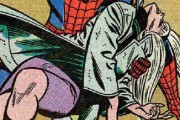Collecting comics can be fun and finding some of the older issues in the proper condition can be challenging. But buying many of these comics can also be downright scary.
Personally, I’ve managed to avoid any major sticker shock through my lifetime of buying Amazing Spider-Man, but that doesn’t mean I’ve never been ripped off. That’s why Michael O’Keefe and Terri Thompson’s 2007 investigation into the most expensive baseball card in history, The Card: Collectors, Con Men and the True Story of History’s Most Desire Baseball Card, struck a very serious chord with me after finally getting a chance to sit down and read the book earlier this month.
While The Card may deal explicitly with the baseball card industry – most notably the hysteria surrounding a near mint condition copy of a T206 Honus Wagner baseball card circa 1909 that’s worth more than $1 million – some of the described predatory tactics deployed by sellers has a lot of relevance to the comic book industry. Collecting is collecting, whether its cards, comics or rare bubble game wrappers. And after reading this book, I have both assurances and nagging concerns regarding my amazing chase as it nears its conclusion.
While there are a few hundred T206 Wagner cards still in circulation, what has made the copy highlighted in The Card so notorious is its pristine condition. It’s the highest graded Wagner card of its kind. When the two authors first got a chance to see the card in-person during a press event, they asked a question that’s both obvious and indicative of a non-collector: where did this come from? Namely, how does a card from 1909 survive nearly 100 years in such fantastic condition? And when the seller in question couldn’t come up with a square answer, that’s where the investigation begins.
What we learn about the card is primarily based on speculation and hearsay, but the information is damaging enough that it should get any collector to think a minute before plopping a month’s rent or far, far more for a piece of memorabilia. There are rumors that the card was actually cut from a full-sheet of cards, which would explain why collectors weren’t even aware of its existence until the mid-1980s. Then there’s the talk that first group of guys who bought it – who now happen to run one of the biggest memorabilia empires in the world – did some tricks to “restore” the card, despite them arguing the contrary (restoration of collectibles like cards and comics is generally considered a no-no, especially if the object in question isn’t being promoted as such). Then there’s discussion of the authorized baseball card grading system and how those results can be skewed in favor of a certain dealer to help him get more money on a sale.
Like everything else in the world, the deeper the authors dig, the smellier the mess becomes. Personally, I’ve tried to safeguard myself against some of these things out of both caution and fiscal necessity. The closer I get to the nitty-gritty of getting every Amazing Spider-Man, the lower my standards have become in terms of the condition of the comics I buy. As I’ve noted on Chasing Amazing in the past, what I’m generally looking for is an attractive flat cover, that’s not covered with writing and is fully in-tact. Things like creases, spine rolls or tears, or even heavy damage to the back cover don’t bother me so much. As long as I can proudly look at the comic in its bag, and not have it disintegrate in my hands when I take it out, I’ll live, especially with the older issues from the 1960s.
By keeping my standards so modest, I’m able to get comics affordably and avoid any potential chicanery from dealers. Simply, someone is not going to put the time and resources into restoring something that’s originally in “Good” condition into a “Very Good” comic. That would be totally inefficient and quite honestly, stupid. But would they take a Very Good comic and restore it into a Very Fine or Near Mint copy, especially when they can potentially make hundreds or thousands of more dollars from that sale? It’s possible.
As for the grading system, I am yet to purchase any Amazing Spider-Man’s that have been professionally graded. Primarily it was because most of these graded comics have an extra premium attached to the price tag, because getting a certified grade ain’t cheap. But now, after reading The Card, I’m a little bit more reluctant about trusting the subjective grade system to boot. I’ve been collecting comics long enough to have a general idea of what passes as what condition. I have a set of eyes. I should just use them. I don’t need a professional grader to tell me what I’m buying.
But just because I’m using caution, doesn’t mean I’m out of the woods. One of the recurring themes of The Card was how those driving sales in the baseball card industry would often try and find ways to exploit certain kinds of collectors. There’s a certain egomania and narcissism in collecting – those who want to be the best, or gain notoriety for owning the best. For me, while I may not be looking for the best looking copy of Amazing Spider-Man #1 that I can find, I am on record in saying one day I aspire to collect every single ASM out there. So whether I’d like to admit it or not, I’m a target.
And because of my goals and desires, I’ve had my fair share of buyer’s remorse, after getting some of my comics. Again, I’m fortunate enough that I haven’t paid one million dollars, or even a thousand dollars for one of those mistakes, but remorse is remorse. I’m sure to get into more detail on some of these instances as I do more “Remembrance of Comics Past” posts in the future, but let’s just say mistakes include buying comics online that were falsely advertised in terms of condition, buying a comic in lousy condition because I panicked and felt the need to walk away from a comic book show or store visit with “something,” and flat-out failing to fully inspect the comic before buying it and finding unforgivable flaws after the fact, like a detached cover or writing in a critical spot on the artwork. In nearly all of these cases, these mistakes were my own, but there weren’t any concerned sellers trying to talk me out of these sales either.
With so many transactions now taking place in cyberspace, it honestly gets scarier. While I often loathe the high-pressure environment of buying an expensive comic in-person, the lack of face-to-face contact makes the world of eBay even harder to navigate. I’ve found a few sellers who I trust and I’m happy with, but these guys aren’t going to continually have everything I’m looking for. I’m going to have to find a way to navigate the minefield of sellers who are both sincere and corrupt, in my quest to collect them all. That means asking questions, examining the provided scans with the utmost care, and most importantly remember those old clichés like “if something is too good to be true, it’s probably not.” Because like the title of the book says, there are a lot of con men out there, and if there’s a buck to be made selling anything vintage or unique, there’s a good chance that those con men are lurking behind every corner and coffee-stained page.






Therein lies the question: what is more worth it?
The object for what it does or what it represents?